Cutlery is the collective term for tools used for eating and serving food. The most common types of cutlery are knives, forks, and spoons. Other words for cutlery are silverware, tableware, and utensils.
These implements are manufactured as silverware, stainless steel, sterling silver, or sterling plate. The various compounds of each metal element used in the production of cutlery are directly attributed to the quality of the product and its longevity through extended use in establishments like restaurants and cafes.
What to consider when selecting cutlery?
- What does 18/10 or 18/0 mean in cutlery?
- Why cutlery rusts
- Cleaning cutlery in dishwashers in a busy environment
- How to prevent cutlery from rusting
- How to remove rust from cutlery
- Your options when purchasing cutlery
What does 18/10 or 18/0 mean in cutlery?
The first number, 18, refers to 18% of chromium content which gives the cutlery its rust-resistant properties. The other number, 10 or 0, refers to the percentage of nickel content that gives cutlery a silvery shine.
Cutlery with a low chromium rating is susceptible to rust which is less than ideal in a high-use environment like a restaurant or café. There’s no denying utensils with low chromium are cheap to purchase. The longevity and staying power of your utensils and cutlery are directly related to the percentage of chromium used in the production.
A cutlery range with an 18/0 rating has no nickel content. This is represented in the second figure and while it is durable, it will not maintain the glossy shine like other ranges with a higher nickel rating. Nickel gives the cutlery its shine and the higher the nickel content, the easier the polishing to retain the cleanly shine customers expect when divulging on your menu.
Why does cutlery rust?
Metals are susceptible to rusting when they meet water and oxygen. A chemical reaction occurs when metal agents come into contact with these elements. The reddish-brown flaky coat on metal is a result of a chemical reaction with oxygen and water – known as oxidization.
Chromium is popular in the manufacturing of stainless-steel cutlery because it hardens and increases corrosion resistance, especially at high temperatures.
The higher the nickel value in cutlery, the stronger it is with regard to resistance to corrosion. As an added bonus, cutlery with high nickel content is easier to clean and it’s able to keep the pristine shine after many uses at the dining table as well as runs through commercial dishwashers. Nickel is known for its ability to enhance form, structure, and ductility while improving corrosion resistance when incorporated correctly in fine cutlery.
When selecting your cutlery, remember – the first figure in the rating stands for the chromium content and the second number stands for the nickel content in production. The higher both numbers are, the better the quality, shine, and durability of the cutlery set you’re purchasing.

Cleaning cutlery in dishwashers
How you load your dishwasher is an important factor in whether or not your cutlery will rust. It all comes down to a science.
When different metals are placed next to each other contact corrosion can happen. This is when metals react not only to water and oxygen but to each other’s elements as well. It is for this reason that silver-plated and stainless-steel cutlery and utensils must be washed in a dishwasher separately. Never wash silver-plated and stainless steel together in the same dishwasher load. The silver and stainless steel chemically react with dishwashing detergents resulting in silver ions disassociating from the silver plates and transferring to the stainless steel. This results in spots on the stainless steel which are difficult to remove without time-consuming handwashing and polishing with dedicated polishing agents.
Cutlery with wooden or plastic handles is not recommended for cleaning in dishwashers as the high temperatures and abrasive cleaning products are likely to result in damage. This is especially the case in busy restaurants and cafes where cutlery may be put through a dishwasher numerous times in one service.
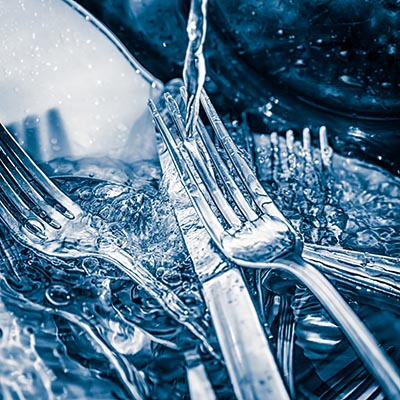
How to prevent cutlery from rusting
The first step in preventing cutlery from rusting is rinsing them immediately after use. Acid and salt, found in most menu items, increase the chance of corrosion.
The cutlery must be washed immediately after rinsing. When these items are left to sit, without immediate washing after rinsing, they are susceptible to rust due to remaining particles reacting with the metal, oxygen, and water.
Do not overuse detergents. Excessive use of detergents in the washing process can impact the chemical reactions that occur during cleaning. It is also vital you do not pour the detergent directly on your cutlery as the chemical reaction can cause irreversible damage due to the chemical reaction that will occur.
Remove cutlery from the dishwasher and thoroughly dry it immediately to remove water,
As a rule of thumb, the longer you leave cutlery in contact with food remnants, other metals, or water, the more likely it is to stain and rust.
If you take the proper precautions, your cutlery will last a long time without damage or staining. The better the quality of cutlery you purchase, and the more attention you pay to its care, will have a significant impact on its life span and value.
How to remove rust from cutlery
If you find yourself in a situation where your cutlery is looking aged and rusted, there are a few simple options you may want to try. There are simple steps you can do to rescue your cutlery and revert them to its original condition.
Soaking rusted cutlery in lemon juice or white vinegar can help alleviate the rust so it’s easier to scrub clean. Fill a clean container with lemon juice (or white vinegar) and let the utensils soak for approximately five minutes. Remove the cutlery and immediately wipe them with a cloth to remove all moisture.
While harsh scourers may seem like an obvious solution, they’ll remove the protective chrome from your stainless-steel cutlery and render them more susceptible to rusting in future. It is ideal to clean rust from cutlery with a soft sponge giving them a longer life of survival and presentation value.
Options when purchasing cutlery
The Melbourne cutlery set is an affordable and durable cutlery collection comprising 12 pieces to suit your business needs within budget. This set is simple in design, sleek, and an affordable addition to your business. The extended range boasts forks, knives, spoons, oyster forks, soda and coffee spoons, and so much more. This is the perfect selection for your busy restaurant or café but you need to pay particular attention to the storage and cleaning of these items to prolong their longevity due to the low nickel content. They won’t keep their sheen without ultimate care and attention.
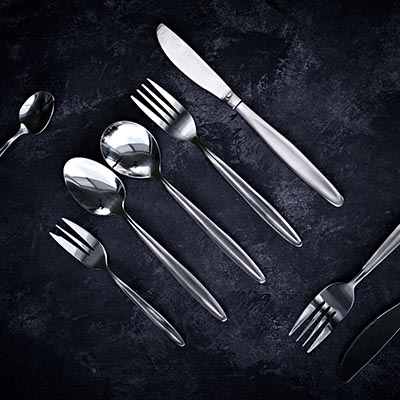

The London cutlery range is ideal for busy restaurants and cafes balancing budget and quality. This 18/10 stainless steel range has modern curved handles with a mirror finish. It will keep shine with adequate care and is a popular staple for many restaurants that appreciate the sophisticated design of this range of cutlery.
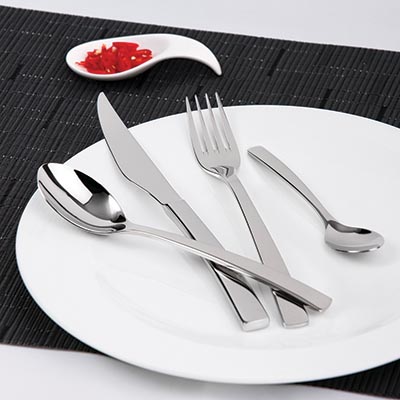

The Style 180 range of cutlery is an 18/0 stainless steel range at an affordable price. This set combines functionality with a beautifully arched handle design that hugs the palm comfortably in use. Available in fork, knife, soup spoon, teaspoon, and more – this set provides luxury on a budget and is a great addition to your arsenal.
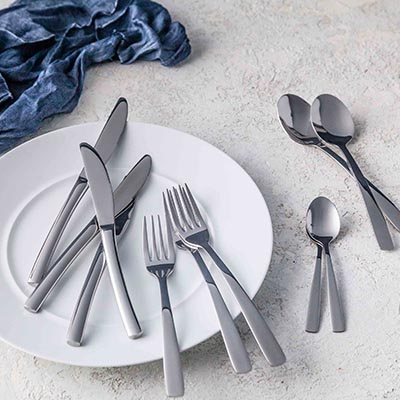

The Izia range of cutlery is what you’re looking for if you’re in the market for standard stainless steel with an 18/10 composition. This contemporary range suits any table setting with quality products making it the ideal choice for your busy restaurant or café.
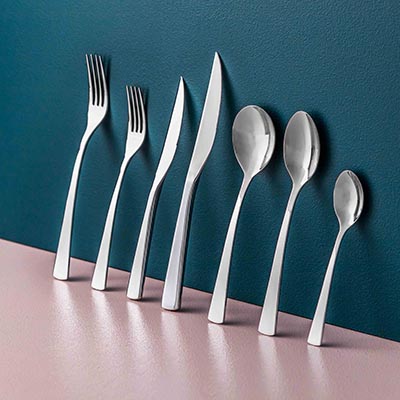

The Vintage Paris range of cutlery is elegant with an 18/10 finish made with 3mm thickness and a mirror finish that will shine your customers’ reflections. This 18/10 stainless steel set encompasses everything you need for a fine dining experience with an elegantly curved handle for balanced handling.
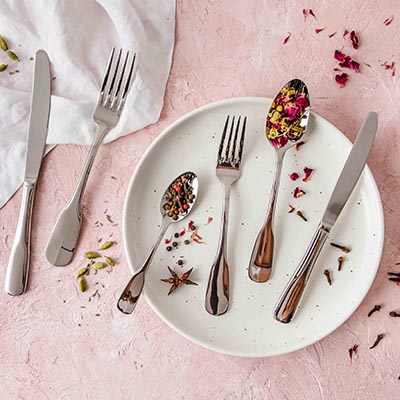

Selecting cutlery for your restaurant or cafe
There are many facets to consider when selecting cutlery for your restaurant, café, or home. The first to consider is the make of the product. The level of quality metals has a direct correlation to the longevity and care required for your cutlery to stand the test of time.
The second facet to take into consideration is your cleaning methods. Metals react with metals while reacting with water and air. You sow the seeds you invest in. If you have little resources to maintain quality materials, you may want to invest more in the quality of your cutlery.
The final factor to consider, which we’ll discuss in another article soon, is the feel and weight of the cutlery you choose to use in your establishment. Is your cutlery just to eat with, or is it part of the experience where your diners feel armed and ready with a weighted utensil in hand ready to conquer your menu?
This is the 101 of selecting cutlery for your business based on the basic facts. Visit our full cutlery catalogue to browse our collection of dining utensils. Don't forget to subscribe to our newsletter for more updates about how you can overwhelm your customers in their next dining experience.